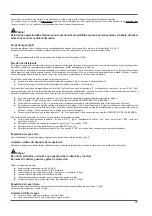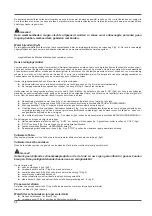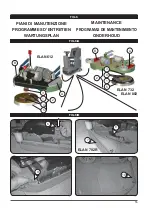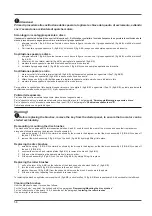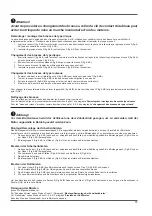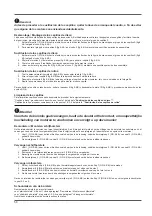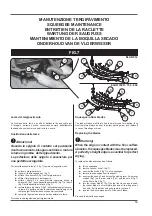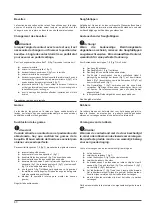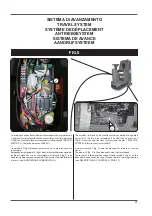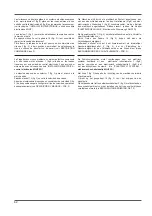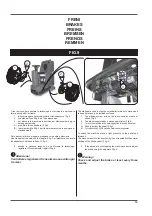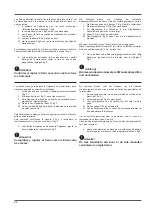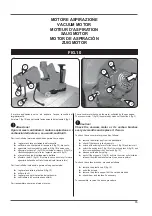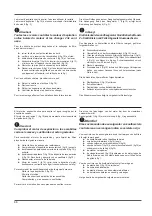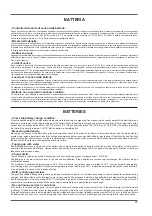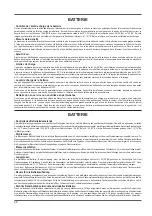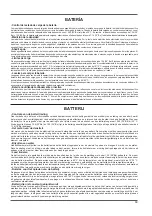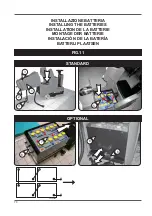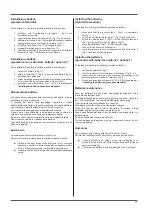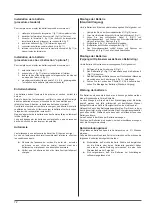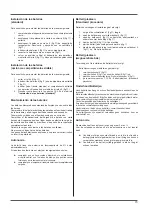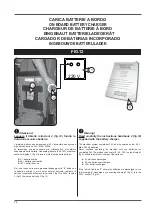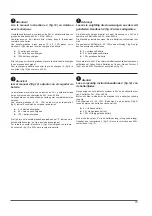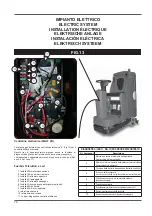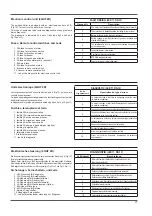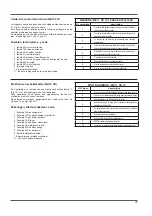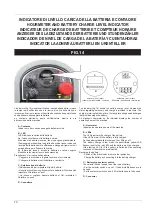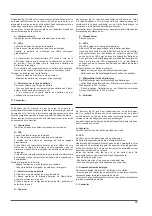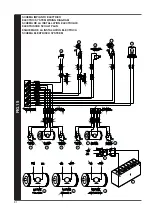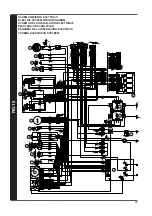
67
BATTERIA
- Controllo dello stato di carica della batteria.
Poiché é acquisito che intercorre una relazione diretta tra il peso speci
fi
co dell’elettrolito e lo stato di carica della batteria, si assume la misurazione del peso speci
fi
co
dell’elettrolito come ef
fi
cace e corretto controllo dello stato di carica della batteria. Quando la batteria é carica ed in condizioni normali, con l’elettrolito al giusto livello
la densità dell’elettrolito sarà di circa 1.260 (30° Bè) riferita a 30° C. Se la densita é invece compresa tra 1.26 (30° Bè) e 1.20 (24 Bè), la batteria é parzialmente carica,
mentre se la densità é inferiore a 1.14 (18° Bè) la batteria é completamente scarica.
- Misura della densitá.
La misura della densitá dell’elettrolito é il più importante controllo su una batteria . Questa misura va quindi eseguita con la massima cura mediante il densimetro,
introducendolo a siringa e prelevando una quantitá di elettrolito suf
fi
ciente a far galleggiare il galleggiante. Fare attenzione che la sommitá di questo non tocchi la pera
di gomma o non resti attaccato con la capillaritá alle pareti di vetro. Se si dovesse fare una misura di densitá dopo un’aggiunta di acqua distillatá si deve attendere che
la densitá sia diventata omogenea in tutto il liquido contenuto nell’elemento.
- Rabbocco acqua.
Aggiungere acqua distillata in ogni singola cella della batteria dopo aver caricato la batteria per portare il liquido al livello 6mm sopra le piastre . L’operazione inizialmente
avverrá dopo ogni carica, in seguito i rabbocchi potranno avvenire meno spesso a seconda dell’esperienza del responsabile, ma mai oltrepassando la settimana fra
l’uno e l’altro rabbocco.
- Limiti di carica.
Non é necessario ricaricare la batteria se la densitá, alla
fi
ne della giornata di lavoro non é scesa al di sotto di 1.24 (28° Bè). L’abuso piú comune riscontrato nell’impiego
della batteria per trazione é la sovraccarica. Questo solo fattore, se applicato continuamente, puó abbreviare drasticamente la durata. La massima temperatura
raccomandata é di 45° C. Se la temperatura dell’elettrolito aumenta di oltre 10/12° C rispetto alla temperatura ambientale, si puó avere la sovraccarica indipendentemente
dal valore della temperatura raggiunta. Se nella batteria rimane una carica residua del 5-10% segnalata sul display del cruscotto , è permesso il traferimento e
l’asciugatura ma non la rotazione delle spazzole ne il lavaggio.
- Locali per la carica della batteria.
I gas che si sviluppano durante l’operazione di carica, presentano pericoli di esplosione, occorre quindi assicurararsi che vi sia libera ventilazione della batteria durante
l’operazione di carica e che i contatti dei morsetti siano sicuri da eventuali scintille. I locali nei quali caricare le batterie di accumulatori devono essere ben aerati, in essi
non si devono veri
fi
care temperature superiori a 40/45° C.
Se attraverso le
fi
nestre non vi é suf
fi
ciente aerazione vi si provvede con speciali condotti di scarico, che non debbono sboccare nelle canne fumarie. Quando é
necessario, il ricambio deve essere reso rapido mediante ventilatori.
- Batteria non in servizio continuo o inattiva.
Se la batteria non viene utilizzata in modo continuo, occorre sottoporla ad una carica di rinfresco una volta al mese, anche se le misurazioni del peso speci
fi
co danno
valori elevati. Se la batteria rimane inattiva per lunghi periodi di tempo deve essere conservata in un luogo fresco e asciutto e una volta al mese deve essere caricata
completamente,
fi
nché si noti in tutti gli elementi un vivace sviluppo di gas e le letture di tensione e di peso speci
fi
co rimangono costanti per 3 - 4 ore. In ogni caso, prima
di rimettere in servizio una batteria rimasta per lungo periodo inattiva, essa deve essere ricaricata e controllata per un giusto livello elettrolitico.
BATTERIES
- Check the battery charge condition
Since the speci
fi
c weight of the electrolyte is proportional to the battery’s charge condition, measuring the speci
fi
c weight of the electrolyte is an
effective, accurate way of checking the charge of the battery. When the battery is charged and in normal conditions, with the electrolyte at the
correct level, its density will be about 1.260 (30° Bè) at 30°C. If the density is between 1.26 (30° Bè) and 1.20 (24° Bè), the battery is partially
fl
at, while if the density is below 1.14 (18° Bè) the battery is completely
fl
at.
- Measuring the density
Measuring the density of the electrolyte is the most important check to be made on a battery, so this measurement must be made with the
greatest care, using a densimeter. Insert the syringe densimeter and draw in enough electrolitye to raise the
fl
oat. Check that the tip of the
fl
oat
does not touch the rubber element, or stick to the glass sides. If the density has to be measured after distilled water has been added, wait until
the density of all the liquid in the element has become uniform.
- Topping up with water
Add distilled water to every single cell of the battery after charging the batteries, to bring the level to 6 mm above the plates. Initially, do this
every time the batteries are charged. Subsequently, top-ups may become less frequently on the basis of the manager’s experience, but must
take place at least once a week.
- Charge limits
There is no need to recharge the battery if the density at the end of the working day has not dropped below 1.24 (28° Bè).
Overcharging is the most common error in the use of drive batteries. If the batteries are continuously overcharged, their lifetime may be
drastically shortened.
The maximum recommended temperature is 45°C. If the electrolyte temperature rises more than 10-12°C over the ambient temperature,
overcharging may occur regardless of the actual temperature reached. If there is a 5-10% residual battery charge indicated on the dashboard,
it is only possible to vacuum, the brushes will stop.
- Battery charging premises
The gases developed during battery charging represent explosion hazard; it is therefore necessary to ensure adequate ventilation during
charging, and
fi
rm contacts on the terminals to prevent any sparks. The premises in which storage batteries are charged mut be well ventilated
and the temperature must not exceed 40-45°C. If ventilation through the windows is not adequate, use special vent ducts, which mut not be
connected to the ordinary chimneys. When necessary, use suitable fans to provide faster air exchange.
- No continuous service or out of use
If the battery is not used continuously, it must be given a “refresher” charge at least once a month, even if the speci
fi
c weight of the electrolyte
is still high. If the battery is out of use for long periods, it must be stored in a cool, dry place. It must be charged once a month completely until
lively gas bubbles are seen in all the elements and the voltage and speci
fi
c weight readings remain constant for 3-4 hours. In all cases, before
a battery which has been out of use for a long time is put back into service, it must be recharged and the elecrolyte level must be checked.
Содержание Elan 612
Страница 98: ...98 ...

